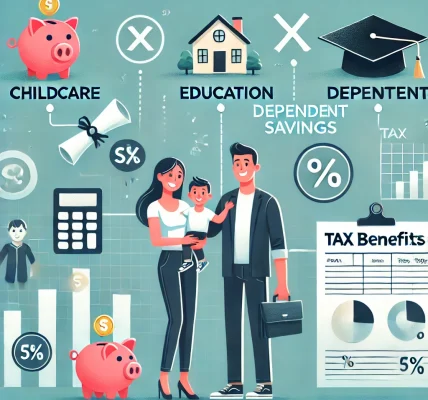As a parent, providing the best education for your children is a top priority. However, the rising costs of education can put a strain on your finances. The good news is that tax planning can help ease this financial burden by offering several ways to claim benefits for your children’s education expenses. By understanding the various tax deductions and exemptions available, you can optimize your tax liabilities and make the most of available resources.
In this blog post, we will walk you through the tax planning strategies that can help parents claim benefits for their children’s education, ensuring that you can save more and plan better for their future.
1. Section 80C: Deduction for Tuition Fees
One of the most common tax-saving provisions for parents in India is under Section 80C of the Income Tax Act. This section offers deductions for various investments and expenditures, including tuition fees paid for children’s education.
- Eligibility: Parents can claim a deduction for tuition fees paid to any recognized educational institution in India. The tuition fees must be for full-time courses that are not part of any sports, entertainment, or extracurricular activities.
- Limit: The maximum deduction available under Section 80C is ₹1.5 lakh in a financial year. This amount is part of the overall limit for deductions available under Section 80C, which includes investments like life insurance premiums, PPF (Public Provident Fund), and more.
- How It Works: You can claim this deduction for the tuition fees of up to two children. Both parents can claim the deduction separately if they are paying the fees from their respective accounts. However, if the tuition fees are paid jointly, only one of the parents can claim the deduction.
2. Section 80E: Deduction for Education Loans
For parents who have taken an education loan to fund their child’s higher education, Section 80E provides tax relief on the interest paid on the loan. This deduction is available for loans taken for the education of children, spouse, or for self-education.
- Eligibility: The loan should be taken from a recognized financial institution or approved charitable institutions for the purpose of pursuing higher education (after the 12th grade).
- Limit: The deduction under Section 80E is available on the interest portion of the loan. There is no upper limit for the amount of interest that can be claimed, and the deduction can be claimed for up to 8 years or until the interest is fully paid, whichever is earlier.
This provision is especially useful for parents who are funding their children’s post-secondary education, as it provides substantial tax relief in the form of deductions for education loan interest.
3. Section 10(16): Scholarship Exemption
If your child receives a scholarship for education, under Section 10(16) of the Income Tax Act, the amount received as a scholarship is exempt from tax.
- Eligibility: Scholarships awarded by educational institutions to students for pursuing studies are fully exempt from tax. This includes merit-based scholarships, government scholarships, or other grants.
- How It Works: Scholarships are not considered income, and therefore, they do not need to be included in your taxable income. This helps parents by reducing their overall taxable income.
4. HRA (House Rent Allowance) for Children’s Education
In some cases, parents may be eligible to claim House Rent Allowance (HRA) if they are renting a home near their child’s educational institution, especially for children studying in other cities. The tax benefit on HRA allows parents to save on rent expenses while managing the cost of education.
- Eligibility: You can claim HRA if you are renting accommodation for your children’s education. It’s essential that the rented accommodation is in the same city as your child’s educational institution.
- How It Works: Parents can claim HRA deductions under Section 10(13A). This can help you reduce your taxable income if your child is attending a school or college away from home and you’re paying rent for the accommodation.
5. Invest in Education Savings Plans
Many parents opt to save for their children’s education through tax-efficient investment options like Education Savings Plans or Child Plans.
- Education Savings Plans: Some financial institutions offer education-specific savings plans that help you systematically save for your child’s future education. These plans offer tax benefits under Section 80C, and the returns from these investments may be exempt from tax.
- Child Plans: These are life insurance policies where the parent is the policyholder, and the beneficiary is the child. The premiums paid for these plans qualify for deductions under Section 80C.
6. Consider Tax-Free Bonds for Long-Term Education Investment
Tax-free bonds are another great way for parents to invest for their children’s education. Tax-free bonds offer fixed interest rates and, as the name suggests, the interest earned is exempt from tax.
- Eligibility: Parents can invest in these bonds to create a long-term corpus for their children’s higher education. The returns from these bonds are not subject to tax, allowing your investment to grow without reducing its value due to taxes.
These bonds can be an attractive option if you’re looking for stable returns with minimal tax impact for long-term educational planning.
7. Plan Early for College Education
One of the best tax-saving strategies for parents is to plan early for their child’s college education. The earlier you start saving and investing for their education, the more tax-efficient and profitable your investments will be in the long run.
- Start investing in PPF or Mutual Funds: Parents can use tax-saving tools such as PPF (Public Provident Fund) or tax-saving mutual funds (ELSS) to grow their savings. These investments not only offer tax deductions but also help build a significant corpus for educational expenses.
Conclusion
Tax planning for children’s education can significantly reduce the financial burden on parents while helping them save money through various tax-saving provisions. By leveraging the deductions under Section 80C and Section 80E, taking advantage of scholarship exemptions, and investing in tax-efficient plans, parents can ensure that they are maximizing their tax benefits and effectively planning for their children’s future education.




